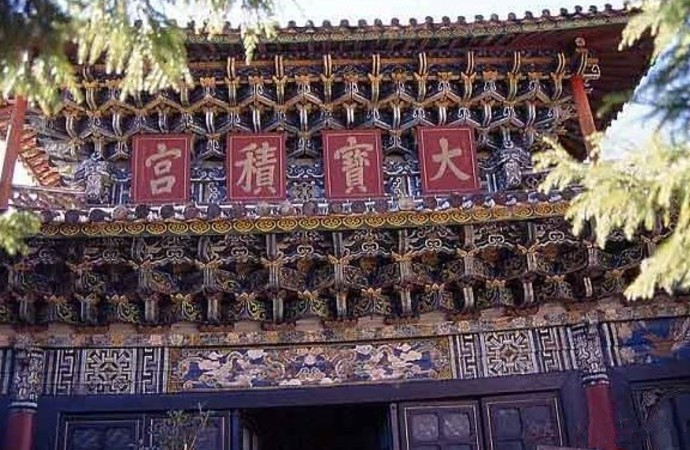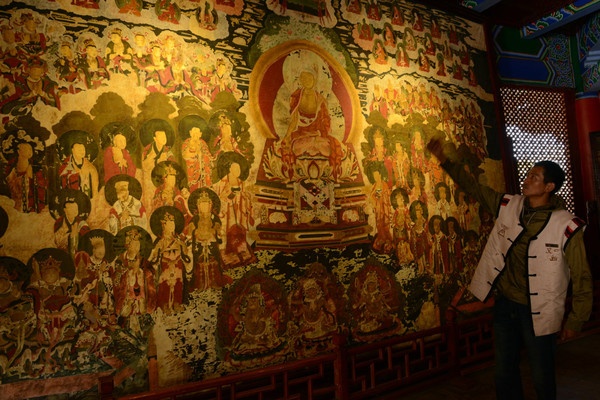Dabaoji Palace in Baisha Old Town, Lijiang
Overview of Dabaoji Palace (大宝积宫)
Dabaoji Palace is a historic site located in Baisha Old Town, approximately 8 kilometers north of Lijiang City. Constructed in the 10th year of the Wanli era (1582) during the Ming Dynasty (明朝), the palace features a double-eaved gable roof and is laid out in a square format. Its numerous murals, painted from the early Ming to the early Qing Dynasties, have persisted for over 300 years. The Baisha Murals (白沙壁画) represent a unique synthesis of Han (汉), Tibetan (藏), and Naxi (纳西) cultures, showcasing various religious and artistic influences, making them invaluable cultural relics.
Key Information
- Chinese Name: 大宝积宫
- Construction Year: 明万历十年 (1582)
- Dynasty: Ming (明)
- Structure Type: Square
Historical Development
Dabaoji Palace faces east and was built in the 10th year of the Wanli era (1582). The palace houses 12 murals, which are the largest and best-preserved in Lijiang. Covering a total area of 61.48 square meters, the most significant mural, titled “The Buddha Giving Teachings” (如来讲经图), measures 3.67 meters high and 4.98 meters wide. The central figure is the Buddha in red robes, seated majestically with 18 disciples depicted above him, while the Four Heavenly Kings are illustrated on either side.
These murals intricately combine figures from Buddhism, Daoism, and Lamaism, reflecting meticulous craftsmanship characterized by delicate lines and an amalgamation of traditional techniques from various ethnic groups, including Han, Tibetan, Naxi, and Bai. In 1996, the palace was designated as a national key cultural relic protection unit, making it an essential resource for the study of ethnic and art history.
Architectural Features
The architectural features of Dabaoji Palace are impressive, with thick columns and beams contributing to its grandeur. Inside the hall, there are 16 murals that span the Ming Yongle period (明永乐年间) to the late Qing Dynasty. The early murals display simplicity in style, while the later works are noted for their bold and rugged lines. The most renowned of these is the Baisha mural, “The Buddha Giving Teachings,” which depicts a variety of activities and stories from Tibetan Buddhism, Han Buddhism, and Daoism, featuring over 100 characters with intricate details and vivid colors. This mural is distinguished by its unification of multiple religious themes and the blending of diverse traditional painting techniques, making it a unique treasure.
Dabaoji Murals (丽江大宝积宫壁画)
The Dabaoji Murals are integral to the murals found in the Mushi Tufu Temple (木氏土府庙宇) in Lijiang, located on Baisha Street (白沙街). Constructed in the 2nd year of the Jiajing era (1523) during the Ming Dynasty, these murals add significant value to the overall importance of Dabaoji Palace.
Key Information
- Chinese Name: 丽江大宝积宫壁画
- Geographic Location: Baisha Street (白沙街), Lijiang
- Construction Year: 明嘉靖二年 (1523)
Mural Characteristics
The murals contain themes such as the Peacock King (孔雀明王) and ritual scenes, as well as elements from esoteric Buddhism and Daoism, demonstrating a rich artistic fusion of Han and Tibetan styles. A total of 12 murals make up this collection, rendering it the most representative and well-preserved site for murals in Lijiang.
Location
Dabaoji Palace is situated 8 kilometers north of Lijiang City on Baisha Street. The Glazed Tile Hall (琉璃殿), facing east, was built in the 15th year of the Yongle era (1417), featuring a double-eaved gable roof and a square layout. The murals inside date from the Ming Yongle period to the late Qing Dynasty, showcasing both early and later artistic styles.
How to Get There
- By Bus: Local buses run from Lijiang City to Baisha Old Town, taking approximately 20 minutes. Look for signs indicating Baisha or nearby attractions.
- By Taxi: Taxis are readily available and provide a convenient option, taking about 20 minutes to reach Baisha.
- By Car: If driving, follow the main road from Lijiang to Baisha, which is well-marked and easy to navigate.
Travel Tips
- Best Time to Visit: Spring (April to June) and autumn (September to November) are the ideal seasons for visiting, offering mild weather and clear skies.
- What to Bring: A camera to capture the stunning murals, sufficient water for hydration, comfortable shoes for walking, and possibly a guidebook for detailed context about the murals and palace.
- Nearby Attractions: Consider visiting other cultural sites in Lijiang, such as the Old Town of Lijiang (丽江古城), a UNESCO World Heritage Site, and the picturesque Black Dragon Pool (黑龙潭), which is renowned for its scenic beauty and reflection of the Jade Dragon Snow Mountain (玉龙雪山).
- Respectful Conduct: As this site is culturally significant, please respect local customs and refrain from loud noise or inappropriate behavior.


















